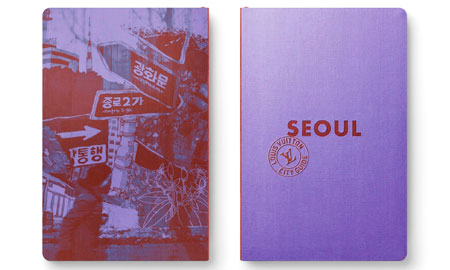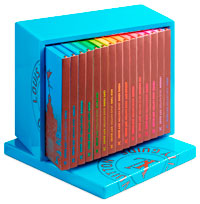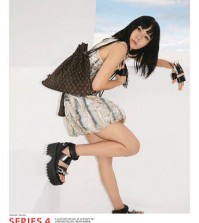- California Assembly OKs highest minimum wage in nation
- S. Korea unveils first graphic cigarette warnings
- US joins with South Korea, Japan in bid to deter North Korea
- LPGA golfer Chun In-gee finally back in action
- S. Korea won’t be top seed in final World Cup qualification round
- US men’s soccer misses 2nd straight Olympics
- US back on track in qualifying with 4-0 win over Guatemala
- High-intensity workout injuries spawn cottage industry
- CDC expands range of Zika mosquitoes into parts of Northeast
- Who knew? ‘The Walking Dead’ is helping families connect
LV’s guide to Seoul
The gems of Seoul one will discover through Louis Vuitton’s first-ever guide to the Korean capital will be far, far beyond expectations. The 320-page book, published Nov. 28, has few photos but is packed with good writing about 600 places around Seoul from top-notch hotels, designer boutiques and the hippest nightclubs to tiny traditional tearooms, inexpensive porridge chains and a market selling medicinal herbs.
Three French authors of the guide, Nicolas Finet, Jean-Yves Ruaux and Michel Temman, have done a striking job at not omitting a single important venue, whether it’s an established restaurant or a gallery.
The sheer number of restaurants in Seoul would overwhelm anyone, but the authors succeeded in picking the best of both fine and casual dining venues celebrated by local epicures — e.g. Min’s Club and Phil Kyung Jae for fine dining and Tosokchon and Mugyodong Bugeotguk for casual dining.
Each entry contains far more details — including the venue’s history and architecture — than those of any other guides this reporter has read. It makes the guide a good read for Seoulites who may be able to see their regular hangouts from different perspectives.
The book is priced 42,500 won and is available at Louis Vuitton stores, as well as large bookstores. It comes in three languages — Korean, English and French.
- Kim Da-ye
Seven selected entries in Louis Vuitton City Guide Seoul
Bicena
267 Itaewon-ro, 2F, Yongsan-gu/ 02 749 6795/ bicena.com
“Relentlessly searching for the very best ingredients and the best possible combinations,” Bicena shines brightly as the star of Korean nouvelle cuisine on Seoul’s culinary stage: authentic and true to its roots, but unafraid to innovate and experiment. There’s certainly no place for wild ostentation or overt flamboyance here. This striking venue has an exceedingly stylish design and exudes a gentle, soothing effect. Purple and gold seats inject a splash of color into the otherwise delicate palette of hues with magical results. Four designers and stylists crafted this exquisite look: Ma Young-bum (interior designer), Shur Young-hee (stylist), Kim Young-jin (hanbok designer) and Ha Ji-hoon (furniture designer). The venue — property of the Kwangjuyo group, which manufactures traditional pottery, amongst other things — serves up health-conscious cuisine, a “culinary voyage of discovery” drawing on the chef’s extensive experience in royal court cuisine, traditional haute cuisine and regional specialties. Acorn jelly and ginseng consomme; with fresh cucumber, pear and winter mushrooms; grilled pork chops with a prawn and garlic flower sauce; grilled mackerel on a bed of barley served with pearl barley and dried acorn and millet jelly. This is Korean cuisine that focuses on using natural ingredients to nourish the body, which in itself is regarded as a little self-contained world. Booking essential.
Seokparang
309 Jahamun-ro, Jongno-gu/ 02 395 2500/ seokparang.co.kr
A jewel in the crown of the city’s historical heritage and a taste of Korean gastronomy that reflects the royal tables of yore. One of the wings of this venerable property, in which an ancient, highly refined style of royal court cuisine is preserved, was relocated in 1958, having previously been part of the residence of Heungseon Daewongun (1820-1898), father of Emperor Gwangmu (1863-1907), regent of Korea from 1863 to 1873 and a key figure in the Joseon era. Impressively orchestrated with the utmost finesse and an overriding sense of calm, every single meal in this exceptional location — amidst sumptuous gardens and courtyards that are home to a 100-year-old persimmon — has the added luxury of being served on valuable ceramics produced by some of Korea’s most famous craftsmen, such as Yi Eun-gu, Yi Bong-ju and Kim Ik-yeong. The multi-course hanjeongsik culinary experience — the living art of the Korean table d’hote — truly reaches its zenith here.
Seoulseo Duljjaero Jalhaneun Jip
122-1 Samcheong-ro, Jongno-gu/ 02 734 5302
Quietly nestled on the Samcheong-dong hillside, this cozy, rustic tearoom opened in 1976 — that is to say, in the hazy olden days of past, going by Korean standards. With its delightfully vintage look, Formica tabletops, 1970s design and an especially tantalizing menu that makes you want to try everything (the persimmon-ginger, jujube and yuja teas are particularly good), this place is never empty. The tearoom, which seats around 40, seems mainly to attract regulars from the local area. Kim Eun-sook, 74, the founder and owner, still treks every morning to the other end of the city to buy fresh herbs, fruits and flowers at Gyeongdong Market, famed for its herbs and medicinal products. She then uses these ingredients to create an exceptional range of authentic flavors but have become a rare commodity.
10 Corso Como
416 Apgujeong-ro, Gangnam-gu/ 02 547 3010/ 10corsocomo.co.kr
With 1,400 square meters of modernity, extravagance and beauty, the Cheongdam branch of 10 Corso Como (its sister shop can be found at Lotte Avenuel department store) has been offering the ultimate in fashion retail therapy since 2008. Always a magnet for lovers of luxury and the latest trends in Seoul, it was given a new lease on life after it provided the backdrop for “Gentlemen,” a video viewed more than a billion times on the web featuring the slick-haired, round-spectacled singer Psy dancing in his trademark black suit, white shirt and two-tone shoes. At the forefront of the “slow shopping” movement, this Milanese brand, founded by Carla Sozzani in 1990, offers customers a mix of art, fashion, music, design, good food and world culture all under one roof. The trill-packed interior of this vast, high-design building, clad in a shell of glass and steel, epitomizes the store’s dedication to perfection and attention to detail, with its interlinked prisms and netting, kaleidoscopic designs and spirals and circles, which can even be found in its black-and-white logo, designed by American artist Kris Ruhs. The ground floor is home to artsy toys, electronic products, decorative objects and books, and stone’s throw from the popular 10 Corco Como Cafe;. The second floor, which has a more sophisticated vibe, is given over to women’s collections, including tailored designs, flowery dresses, frilly jackets, high heels and court shoes. The selection also includes sharp suits, impeccable tailoring and chic sportswear for the casual man-about-town. At the cutting edge of design, this concept store is the place to beat for trendy treasure hunters.
Gyeongdong Market
3 Gasanja-ro 36-gil, Dongdaemun-gu/ 02 967 8721/ kyungdongmart.com
This market, opened in 1960, is one of the country’s largest venues for buying herbal medicine, supplying 70 percent of the country’s traditional medicine needs. Shoppers come here to buy ginseng, lotus leaves, bellflower and other perennial herbs, tea extracts such as Schisandra berries and cornus fruits, Solomon’s seal, which is very rare, and other monocotyledons.
Design Library
31-18 Bukchon-ro, Jongro-gu/ 02 3700 2700/ library.hyundaicard.com
Opened in March 2013 and designed by Choi Wook from architectural firm One o One, this splendid Bauhaus-inspired building in central Bukchon is home to a collection of 11,500 works exclusively devoted to design, photography, architecture and visual communication, selected by an international team of curators and critics. It also contains Korean and international journals, such as the Domus architectural review and a complete set of American magazine Life. Besides the two sleek, light-filled floors occupied by the library and comfortable reading areas, Design Library also has a space for temporary exhibitions and a ground floor cafe — the only area open to the general public. Sponsored by Korea’s biggest credit card company, Hyundai Card, the library has opted for a selective membership policy: only Hyundai cardholders and their guests can access the library for a maximum of eight visits per month.
Startlight
402-18 Seogyo-dong, Mapo-gu/ 02 337 1886
Opened in 2001 (an eternity in Seoul), the rather off-beat Starlight attracts a crowd of regulars who appreciate its extraordinary collection of vinyl records. Consisting of tens of thousands of LP’s stored on endless wooden shelves, it covers every musical movement from the 1970s to the 1990s from Hotel California by the Eagles to Don’t Look Back in Anger by Oasis, played on high-quality loudspeakers. Customers, who love its warm 70’s atmosphere and eclectic drinks list, pass on requests for their favorite hits to the DJ on chits of yellowing paper. The bar’s owner, Yoo Min-kyu, is a big fan of the decks. A DJ while still in high school, it has been his passion ever since.















2018
August 4, 2017 at 5:21 PM
we are amazing
plants
October 17, 2017 at 3:44 AM
SocialAnxietySupport.com